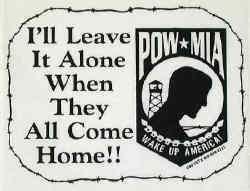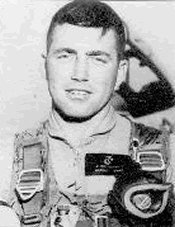![]()
![]()












![]()
![]()
![]()
|
|
||||
|
||||
|
SCHMIDT, WALTER ROY, JR. |
|
|||
Loss Coordinates: 161919N
1070726E (YD273053) SYNOPSIS: The Douglas A4 Skyhawk was a single-seat light attack jet flown by both land-based and carrier squadrons, and was the US Navy’s standard light attack aircraft at the outset of the war. It was the only carrier-based aircraft that did not have folding wings as well as the only one that required a ladder for the pilot to enter/exit the cockpit. The Skyhawk was used to fly a wide range of missions throughout Southeast Asia including close air support to American troops on the ground in South Vietnam. Flying from a carrier was dangerous and as many aircraft were lost in “operational incidents” as in Combat. On 9 June 1968, then 1st Lt. Walter R. Schmidt, Jr. was the pilot of an A4E Skyhawk (serial # 151080), call sign “Hellborne 215,” that was conducting a mid-morning multiple aircraft direct combat support mission for US troops fighting in the infamous A Shau Valley, Thua Thien Province, South Vietnam. This area also included a primary gateway from the equally notorious Ho Chi Minh Trail into strategic sections of northern South Vietnam. When North Vietnam began to increase its military strength in South Vietnam, NVA and Viet Cong troops again intruded on neutral Laos for sanctuary, as the Viet Minh had done during the war with the French some years before. This border road was used by the Communists to transport weapons, supplies and troops from North Vietnam into South Vietnam, and was frequently no more than a path cut through the jungle covered mountains. US forces used all assets available to them to stop this flow of men and supplies from moving south into the war zone. At 1020 hours, after making a bombing run on an enemy position, 1st Lt. Schmidt’s aircraft was struck by ground fire. His aircraft continued to the northwest and crashed in the densely forested mountains approximately 5 miles northwest of the northern edge of the A Shau Valley, 2 miles northeast of the South Vietnamese/Lao border and the same distance southwest of a primary road leading from the Ho Chi Minh Trail. This road ran east/west from the border eastward to a point near the northern tip of the A Shau Valley. It then turned south-southeast running along the full length of the east side of the dense jungle covered valley. Walter Schmidt was seen to eject from his crippled Skyhawk and descend safely to the ground. Other pilots saw his parachute caught in trees and were able to immediately establish voice contact with him. He reported to the other pilots that he sustained a broken leg while ejecting and was unable to move. Search and rescue (SAR) aircraft were immediately called to pick up the downed pilot, and as they arrived on site, NVA troops were observed approaching Walter Schmidt’s position. US Coast Guard LT. Jack C. Rittichier, pilot; and US Air Force Capt. Richard C. Yeend, Jr., Co-pilot; SSgt. Elmer L. Holden, flight engineer; and Sgt. James D. Locker, Pararescueman; comprised the crew of a HH3E helicopter (tail #67-14710), call sign “Jolly Green 23,” that was assigned to the SAR mission to rescue 1st Lt. Schmidt. As the Jolly Green Giant hovered over the rugged jungle covered mountains approximately 9 miles northwest of the A Shau Valley floor near the downed pilot, the helicopter was struck by heavy enemy ground fire. It was seen to fall to the ground in flames and disintegrate upon impact by the onsite Forward Air Controller (FAC) just to the west of a primary road used by the communists to infiltrate troops and supplies into South Vietnam from the Ho Chi Minh Trail. The location of loss was approximately 1300 meters northeast of the village of Ka Kou, 12 miles northwest of the village of A Luoi, 25 miles southeast of Khe Sanh and 29 miles west-southwest of Hue. This location was also 4 miles north of the South Vietnamese/Lao border, near the border between Thua Thien and Hue Provinces. Another aircraft flew over the wreckage, but its crew saw no survivors and heard no emergency beeper signals. Because of the intense enemy presence in the area, no ground search was possible. At the time the formal SAR was terminated, Jack Rittichier, Richard Yeend, Elmer Holden and James Locker were immediately listed Killed in Action/Body Not Recovered. At first light the next morning a ground team was inserted into the area of loss. During their search in and around the area where Walter Schmidt landed, no trace of the wounded pilot or his parachute could be found. Further, all attempts to re-establish radio contact with him proved futile. Under the circumstances, at the time formal SAR efforts were terminated, Walter Schmidt was listed Prisoner of War. In early 1973, 591 American Prisoners of War were released by the communists during Operation Homecoming. All returnees were debriefed by US intelligence to include any information each possessed about other Americans who were known or believed to be prisoners and who were not released from captivity. According to two returnees, one Navy jet pilot and one Army helicopter pilot, who were released from one of the camps in Hanoi, Walter Schmidt “had a difficult time adapting to capture. He was frequently sick and always gave the guards a hard time.” The last time the Army pilot heard him was in July-August 1971. At that time, 1st Lt. Schmidt was heard screaming, “Do not push me.” That was followed by a gunshot. In conjunction with Operation Homecoming, the North Vietnamese released a list of American Prisoners of War who they state died in captivity. Walter Schmidt is not included in this list of Americans who died while under the control of the communists. In April 1991 the US government released a list of Prisoners of War and Missing in Action who were known to be alive in enemy hands and for whom there is no evidence that he or she died in captivity. This list, commonly referred to today as the USG’s “Last Known Alive” list, includes 1st Lt. Schmidt. Whether the North Vietnamese murdered Walter Schmidt in 1971, or whether he survived this encounter with a guard is unknown. However, either way there is no question the Vietnamese could return him to his family, friends and country any time they had the desire to do so. Since the end of the Vietnam War well over 21,000 reports of American prisoners, missing and otherwise unaccounted for have been received by our government. Many of these reports document LIVE American Prisoners of War remaining captive throughout Southeast Asia TODAY. Pilots in Vietnam were called upon to fight in many dangerous circumstances, and they were prepared to be wounded, killed or captured. It probably never occurred to them that they could be abandoned by the country they so proudly served. The information here is courtesy of:
|
||||



